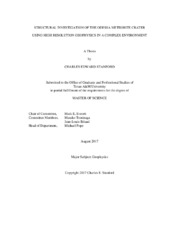| dc.description.abstract | From its discovery in 1921, the Odessa Meteorite Crater has interested researchers and mining companies who had initially hoped to locate a buried mass of meteoric iron. To find the impactor, a major geologic study of the crater was conducted in 1941. Even though the impactor has not been found, the thorough geologic constraints make the crater an excellent location to test the application of near-surface geophysical methods to complex environments. Recently, researchers have focused on determining the age of the crater, the environmental effects of the impact, and the size, incident angle, and direction of the impactor responsible for the crater. However, the heavily eroded and anthropogenically modified state of the exposed crater presents several challenges to impactor attribute estimation. The exposed rim is irregular in shape such that the original size and shape of the crater is indeterminate, only ~3 m of the estimated 30 m of original crater depth remain unfilled by post impact sediment, and previous geologic studies have left the remains of several large trenches transecting the crater rim.
To more accurately determine the original size of the crater, ERT and GPR geophysical methods were used to image the exposed and unexposed rim strata. However, the geologic complexity of the crater and the presence of anthropogenic or “cultural” noise posed problems to both ERT and GPR data acquisition and processing. Geophysical results point to a main crater of ~120 m in diameter and ~35 m depth. Additionally, the eastern non-circular portion of the expose crater rim is hypothesized to have form from the simultaneous impact of a small meteorite broken from the main meteorite during atmospheric entry. Further ERT study is recommended to investigate the secondary crater further. | en |


